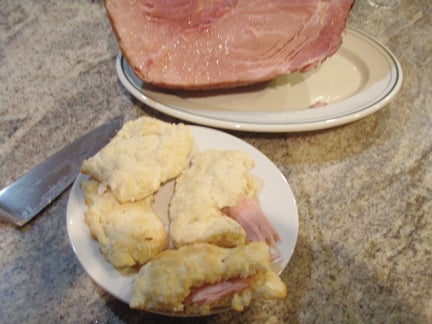Holiday ham means a happy family at the holiday table
Published 12:01 am Saturday, December 22, 2012
Now is the time to make some decisions about cooking Christmas dinner. I have never done a Christmas ham, but decided this was the year to be a little more traditional. The goose last year was not a big hit. It was expensive and did not have a lot of meat for leftovers. But, I gave it a shot, and don’t have to revisit the goose any time soon.
All over the world, cured port is a celebrated feast food. It is a simple pleasure but can be complicated in its own way. Most people grow up eating the sweet, juicy, pink hams with a caramelized crust. Think honey baked! Then, there are the salty, complex, country hams, which taste so different. I grew up with the salty country hams. My father was really good at curing hams and they were wonderful and I miss them.
Smithfield is where American ham began and where its evolution has played out for the past four centuries. Jamestown, site of the earliest English colony in North America, is just a few miles upriver; the settlers who brought pigs to the New World started confining hogs on a nearby island, called Hog Island, to raise them for ham, and in 1779, a sea captain named Mallory Todd started to ship hams from Smithfield to the British West Indies. The Virginia trade eventually spread to England, where Queen Victoria placed a standing order for six a week.
Smithfield had all the right conditions for ham making. It had the hogs – a flavorful, fatty razorback variety. It had cheap feed, peanuts, which grew in abundance and gave the hogs a uniquely nutty flavor. It had access to the sea (for salt) and to the James River, which allowed for easy transport. And it had the perfect climate; hot during the day and cool at night, with the four seasons necessary for hams to undergo a proper cutting.
In the 1930s and 1940s, ham production, and ham itself, started to change. With the advent of refrigeration, temperature-controlled aging rooms could replicate the changing of the seasons, so country hams could be produced year-round. More important, refrigeration allowed for the production of lightly cured “city” hams, which were injected with brine to speed up the curing process and shipped in refrigerated railcars. Americans fell in love with the sweet flavor of city hams, and producers churned them out in great numbers. So over time, Smithfield became the pork capital of the country. Now this company is called Smithfield Foods and processes some 20 million hams a year, and only 45,000 are the dry-cured, hickory-smoked Genuine Smithfield hams. Edwards Virginia Tradition hams in Surry, Va., is another source as is Trigg County hams in Cadiz, Ky., and Benton’s hams in Madisonville, Tenn.
A few tips in buying your ham: Check the label. Products labeled simply “ham” are of the highest quality grade and the costliest. Those labeled “ham in natural juices” can be a good value; they contain extra water and remain juicy when baked. Avoid products labeled “ham and water product”; they contain as much water as can be pumped into the ham and have a diluted bland flavor. A whole bone-in ham delivers the best flavor, texture, and value. A semi-boneless ham has a portion of the bone removed for easier carving and cooks much faster than a bone-in ham. Many semi-boneless hams come pre-sliced or “spiral cut,” which makes for easier slicing.
I went to Whole Foods and got a small ham to use for my Christmas meal. I was somewhat late to order from Smithfield Foods. I am going to add a glaze to the ham and then also use the ham for Christmas morning biscuits. The biscuit recipe comes from the Old Chickahominy House in Williamsburg, Va.
They sell about 600 biscuits every day and roll the dough thin and cut in rectangles so the country ham can shine through.
Taken from Saveur Magazine, December 2009
Apricot-Ginger Glazed Ham
1 7-12lb. half semiboneless ham
1 tbsp. canola oil
1 tbsp. minced fresh ginger
½ cup apricot preserves or jam
½ cup packed dark brown sugar
¼ cup apple cider vinegar
Heat oven to 350 degrees. Wrap ham in foil; transfer to a roasting pan. Bake until a thermometer inserted into the deepest part of the ham reads 145 degrees, about 12-20 minutes per pound.
Meanwhile, heat oil in a 1-quart saucepan over medium-high heat. Add ginger; cook until soft, for two to three minutes. Add preserves, sugar and vinegar; cook, stirring, until mixture becomes a syrupy glaze, about 10 minutes.
Unwrap ham and brush with some glaze; raise oven to 500 degrees. Bake, brushing occasionally with remaining glaze, until browned, about 20 minutes more. Let rest for 20 minutes before carving.
Country Ham Biscuits
Makes 12 biscuits
2 cups self-rising flour
4 tbsp. lard or butter
1 cup buttermilk
4 oz. thinly sliced cooked country ham
Heat oven to 425 degrees. Sift flour into a large bowl; mix in lard or butter until the mixture has the consistency of cornmeal. Using a wooden spoon, stir in buttermilk to form a dough. Transfer dough to a floured work surface; knead briefly until smooth. Roll dough into a ¼ “-thick rectangle. Cut dough into 12 4”x3” rectangles, transfer to a baking sheet. Bake until golden brown, about 15-20 minutes. Cool slightly. To serve, slice biscuit and stuff with ham.
Merry Christmas!






